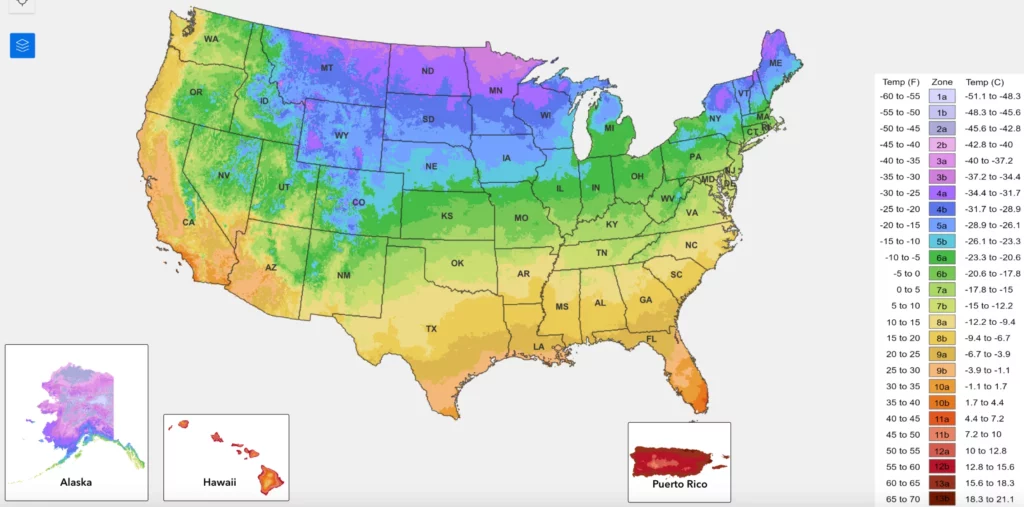Find Your USDA Zone
What Is a USDA Hardiness Zone?
A USDA Hardiness Zone is a geographic area defined by the U.S. Department of Agriculture based on average annual minimum winter temperatures. This handy classification helps gardeners pinpoint plants that are most likely to survive and thrive in their local climate. Both the United States and Canada use this system, with zones ranging from Zone 1 (coldest) to Zone 13 (warmest).
How the Zone System Works?
Understanding the Basics
Each USDA Zone represents a 10°F temperature range, based on long-term historical weather data. These zones reflect the lowest temperatures typically experienced in winter, providing crucial insights into plant survival.
Breaking Down Subzones
To further refine plant recommendations, each zone is divided into two subzones:
- Subzone “a”: Covers the colder half (e.g., Zone 6a ranges from -10°F to -5°F).
- Subzone “b”: Covers the warmer half (e.g., Zone 6b ranges from -5°F to 0°F).
This detailed split helps gardeners make precise choices, especially when dealing with plants sensitive to even small temperature variations.
How to Find Your Garden’s USDA Zone?
- Enter Your ZIP Code: Type your zip code into our easy-to-use tool below.
- Instant Results: Get your precise USDA Zone and subzone immediately.
- Explore Suitable Plants: Unlock recommendations explicitly tailored to your garden’s unique climate.
Try it now to ensure gardening success!
A Glimpse at the Gardener’s Map
Curious about the bigger picture? The official USDA Plant Hardiness Zone Map illustrates the U.S. with vibrant colors:
- Cool purples and blues represent the coldest regions, typically Zones 1–5.
- Moderate greens and lighter blues highlight temperate climates, approximately Zones 6–7.
- Warm yellows, oranges, and reds indicate warmer, subtropical to tropical regions, covering roughly Zones 8–13.
Please take a look at our interactive map below or visit the official USDA site for a closer exploration. It’s like taking a virtual tour of the climate coast-to-coast!

Crafted by the USDA Agricultural Research Service & Oregon State University.
Why Knowing Your USDA Zone Matters?
Your USDA Zone is the secret to gardening success. It directly informs which plants will comfortably survive your area’s winter conditions and which may need special attention or indoor overwintering.
Navigating Microclimates
Every garden has its quirks. Factors such as:
- Sunny walls radiating warmth
- Sheltered courtyards reducing frost
- Shady, moist spots cooling temperatures
can create microclimates within your primary zone. Recognizing these nuances helps you strategically place plants for optimal health and growth.
Local Knowledge Is Power
Combine your zone information with insights from your local garden center. They understand regional specifics (soil types, humidity levels, rainfall patterns) that help fine-tune your gardening choices.
Garden Gossip: Fun Facts By Zone
Every USDA Zone has its quirks and a few juicy secrets. From unexpected plant heroes to climate-defying crops, here’s the dirt gardeners love to dish about each region:
- Zones 1–2 (−60 to −40 °F): Cold frames help Alaskans grow kale and snapdragons in brief summers.
- Zones 3–4 (−40 to −20 °F): Peonies shine here. Even wine grapes grow with the right setup.
- Zones 5–6 (−20 to 0 °F): Hostas, hydrangeas, and tomatoes thrive, especially with wide temperature swings.
- Zones 7–8 (0 to 20 °F): Double tomato harvests, camellias, and well-loved backyard figs.
- Zones 9–10 (20 to 40 °F): Bougainvillea, citrus, and hibiscus bloom with ease year-round.
- Zones 11–13 (above 40 °F): Tropicals like mango, plumeria, and orchids flourish outdoors.
Your zone’s got stories. Ask your local gardening club and you’ll hear tales of daring zone-pushing, legendary harvests, and backyard wonders. What’s your garden gossip??
Next Steps: Grow with Confidence!
Ready to turn your garden dreams into reality? Explore our carefully curated Plant Care Guides tailored specifically to your USDA Zone. Discover plants that are guaranteed to flourish, making your garden not just beautiful, but also resilient.
Your garden journey starts here. Good luck! 🌱
